ABS NISSAN LEAF 2019 Owner´s Manual
[x] Cancel search | Manufacturer: NISSAN, Model Year: 2019, Model line: LEAF, Model: NISSAN LEAF 2019Pages: 610, PDF Size: 7.11 MB
Page 19 of 610
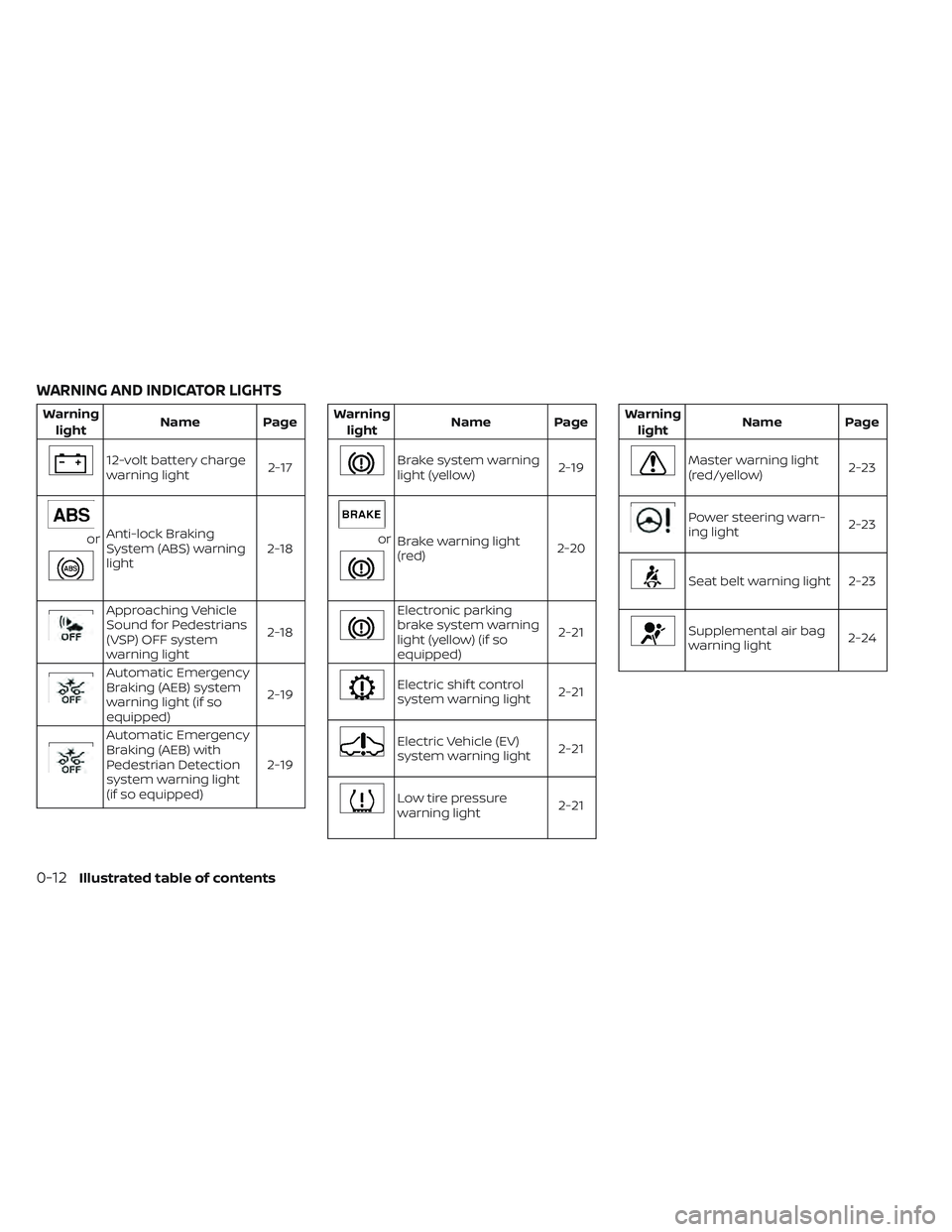
Warninglight Name Page
12-volt battery charge
warning light
2-17
orAnti-lock Braking
System (ABS) warning
light2-18
Approaching Vehicle
Sound for Pedestrians
(VSP) OFF system
warning light2-18
Automatic Emergency
Braking (AEB) system
warning light (if so
equipped) 2-19
Automatic Emergency
Braking (AEB) with
Pedestrian Detection
system warning light
(if so equipped)2-19
Warning
light Name Page
Brake system warning
light (yellow)
2-19
orBrake warning light
(red)2-20
Electronic parking
brake system warning
light (yellow) (if so
equipped) 2-21
Electric shif t control
system warning light
2-21
Electric Vehicle (EV)
system warning light2-21
Low tire pressure
warning light2-21
Warning
light Name Page
Master warning light
(red/yellow)
2-23
Power steering warn-
ing light2-23
Seat belt warning light 2-23
Supplemental air bag
warning light2-24
WARNING AND INDICATOR LIGHTS
0-12Illustrated table of contents
Page 188 of 610
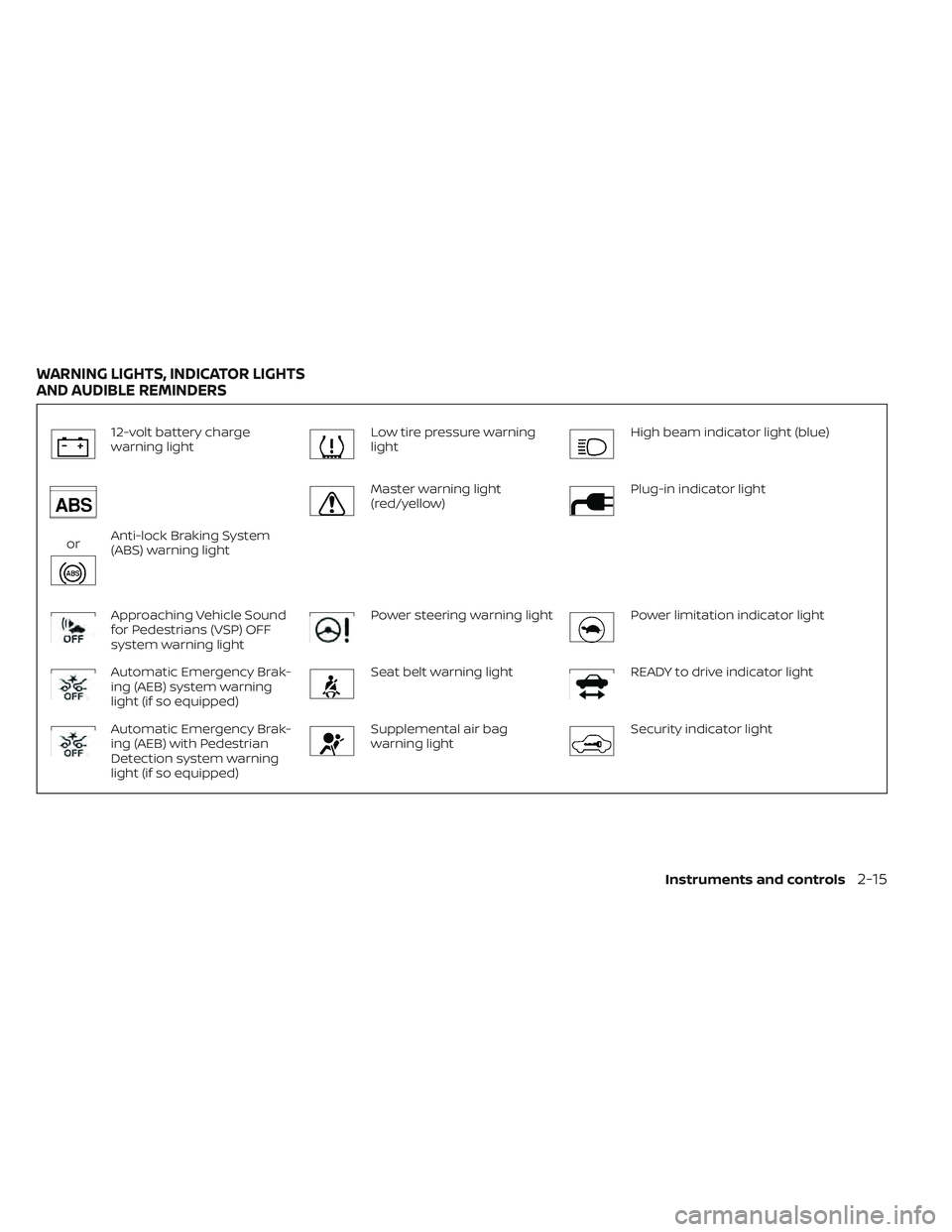
12-volt battery charge
warning lightLow tire pressure warning
lightHigh beam indicator light (blue)
orAnti-lock Braking System
(ABS) warning light
Master warning light
(red/yellow)Plug-in indicator light
Approaching Vehicle Sound
for Pedestrians (VSP) OFF
system warning lightPower steering warning lightPower limitation indicator light
Automatic Emergency Brak-
ing (AEB) system warning
light (if so equipped)Seat belt warning lightREADY to drive indicator light
Automatic Emergency Brak-
ing (AEB) with Pedestrian
Detection system warning
light (if so equipped)Supplemental air bag
warning lightSecurity indicator light
WARNING LIGHTS, INDICATOR LIGHTS
AND AUDIBLE REMINDERS
Instruments and controls2-15
Page 191 of 610
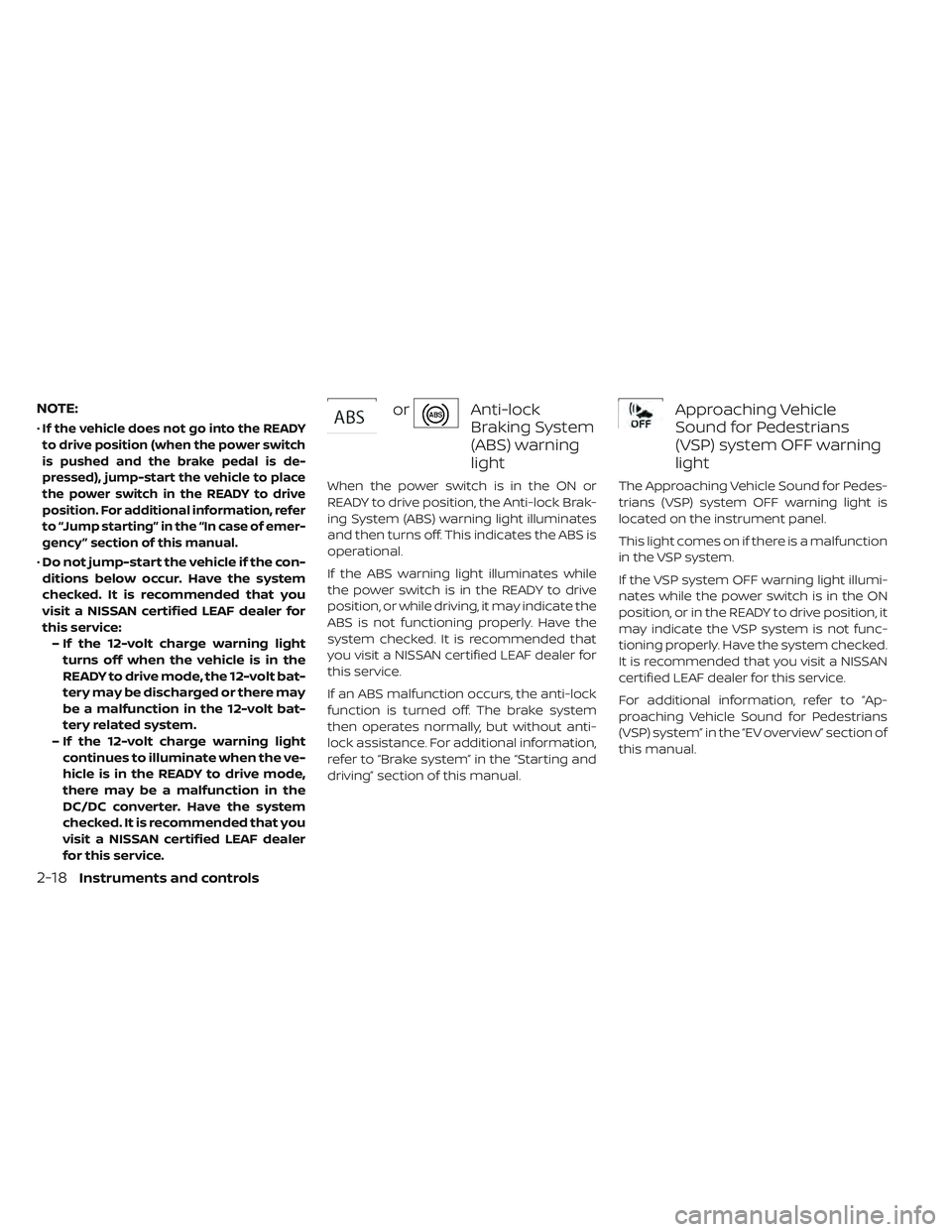
NOTE:
•If the vehicle does not go into the READY
to drive position (when the power switch
is pushed and the brake pedal is de-
pressed), jump-start the vehicle to place
the power switch in the READY to drive
position. For additional information, refer
to “Jump starting” in the “In case of emer-
gency ” section of this manual.
•Do not jump-start the vehicle if the con-
ditions below occur. Have the system
checked. It is recommended that you
visit a NISSAN certified LEAF dealer for
this service:
– If the 12-volt charge warning light turns off when the vehicle is in the
READY to drive mode, the 12-volt bat-
tery may be discharged or there may
be a malfunction in the 12-volt bat-
tery related system.
– If the 12-volt charge warning light continues to illuminate when the ve-
hicle is in the READY to drive mode,
there may be a malfunction in the
DC/DC converter. Have the system
checked. It is recommended that you
visit a NISSAN certified LEAF dealer
for this service.
orAnti-lock
Braking System
(ABS) warning
light
When the power switch is in the ON or
READY to drive position, the Anti-lock Brak-
ing System (ABS) warning light illuminates
and then turns off. This indicates the ABS is
operational.
If the ABS warning light illuminates while
the power switch is in the READY to drive
position, or while driving, it may indicate the
ABS is not functioning properly. Have the
system checked. It is recommended that
you visit a NISSAN certified LEAF dealer for
this service.
If an ABS malfunction occurs, the anti-lock
function is turned off. The brake system
then operates normally, but without anti-
lock assistance. For additional information,
refer to “Brake system” in the “Starting and
driving” section of this manual.
Approaching Vehicle
Sound for Pedestrians
(VSP) system OFF warning
light
The Approaching Vehicle Sound for Pedes-
trians (VSP) system OFF warning light is
located on the instrument panel.
This light comes on if there is a malfunction
in the VSP system.
If the VSP system OFF warning light illumi-
nates while the power switch is in the ON
position, or in the READY to drive position, it
may indicate the VSP system is not func-
tioning properly. Have the system checked.
It is recommended that you visit a NISSAN
certified LEAF dealer for this service.
For additional information, refer to “Ap-
proaching Vehicle Sound for Pedestrians
(VSP) system” in the “EV overview” section of
this manual.
2-18Instruments and controls
Page 362 of 610
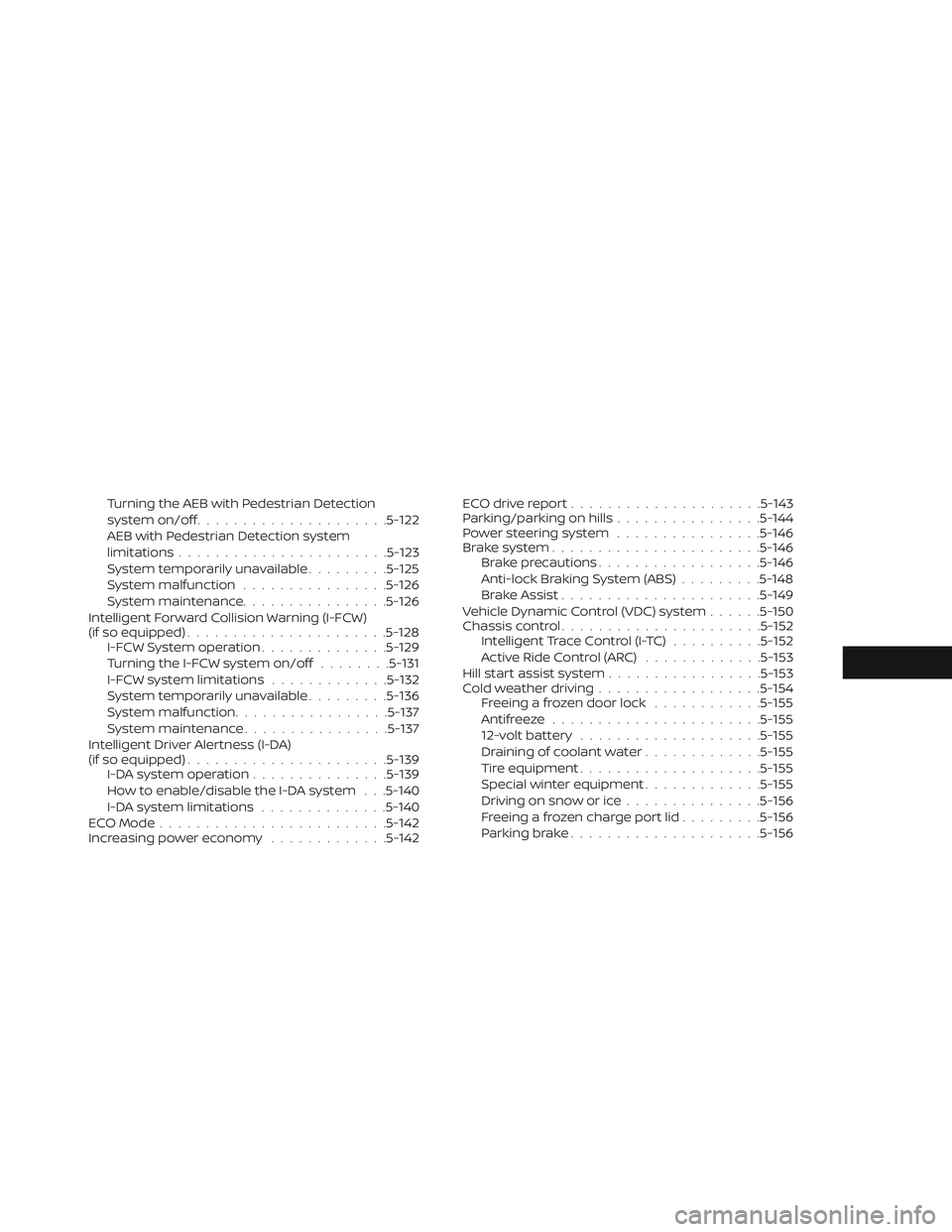
Turning the AEB with Pedestrian Detection
system on/off.................... .5-122
AEB with Pedestrian Detection system
limitations .......................5-123
System temporarily unavailable .........5-125
System malfunction ................5-126
System maintenance ................5-126
Intelligent Forward Collision Warning (I-FCW)
(if so equipped) ......................5-128
I-FCW System operation ..............5-129
Turning the I-FCW system on/off ........5-131
I-FCW system limitations .............5-132
System temporarily unavailable .........5-136
System malfunction ................ .5-137
System maintenance ................5-137
Intelligent Driver Alertness (I-DA)
(if so equipped) ......................5-139
I-DA system operation ...............5-139
How to enable/disable the I-DA system . . .5-140
I-DA system limitations ..............5-140
ECO Mode .........................5-142
Increasing power economy .............5-142 ECO drive report
.................... .5-143
Parking/parking on hills ................5-144
Power steering system ................5-146
Brake system .......................5-146
Brake precautions ................. .5-146
Anti-lock Braking System (ABS) .........5-148
Brake Assist ......................5-149
Vehicle Dynamic Control (VDC) system ......5-150
Chassis control ......................5-152
Intelligent Trace Control (I-TC) ..........5-152
Active Ride Control (ARC) .............5-153
Hill start assist system ................ .5-153
Cold weather driving ................. .5-154
Freeing a frozen door lock ............5-155
Antifreeze .......................5-155
12-volt battery ................... .5-155
Dr aining
of coolant water .............5-155
Tire equipment ................... .5-155
Special winter equipment .............5-155
Driving on snow or ice ...............5-156
Freeing a frozen charge port lid .........5-156
Parking brake .................... .5-156
Page 394 of 610
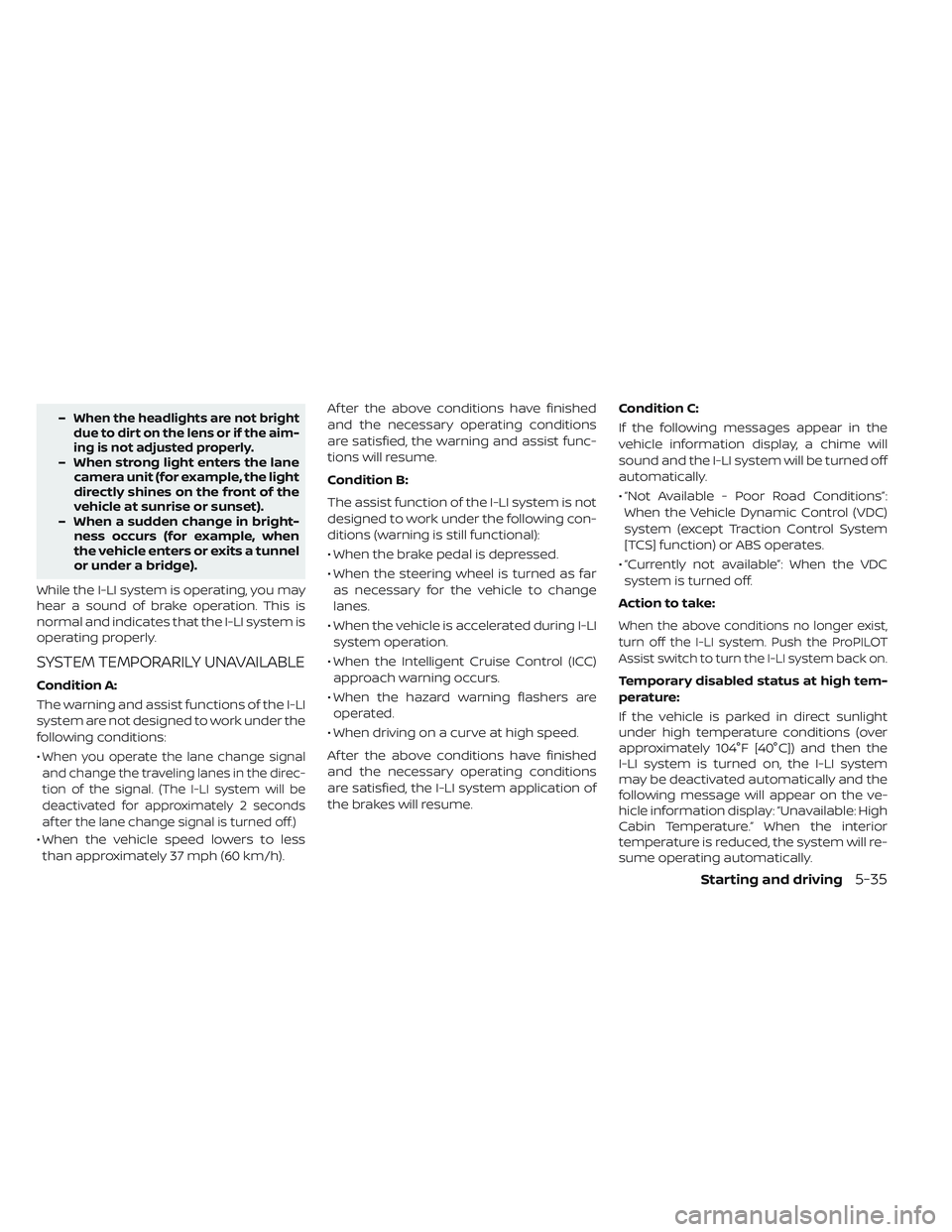
–When the headlights are not bright
due to dirt on the lens or if the aim-
ing is not adjusted properly.
– When strong light enters the lanecamera unit (for example, the light
directly shines on the front of the
vehicle at sunrise or sunset).
– When a sudden change in bright- ness occurs (for example, when
the vehicle enters or exits a tunnel
or under a bridge).
While the I-LI system is operating, you may
hear a sound of brake operation. This is
normal and indicates that the I-LI system is
operating properly.
SYSTEM TEMPORARILY UNAVAILABLE
Condition A:
The warning and assist functions of the I-LI
system are not designed to work under the
following conditions:
•
When you operate the lane change signal
and change the traveling lanes in the direc-
tion of the signal. (The I-LI system will be
deactivated for approximately 2 seconds
af ter the lane change signal is turned off.)
• When the vehicle speed lowers to less than approximately 37 mph (60 km/h). Af ter the above conditions have finished
and the necessary operating conditions
are satisfied, the warning and assist func-
tions will resume.
Condition B:
The assist function of the I-LI system is not
designed to work under the following con-
ditions (warning is still functional):
• When the brake pedal is depressed.
• When the steering wheel is turned as far
as necessary for the vehicle to change
lanes.
• When the vehicle is accelerated during I-LI system operation.
• When the Intelligent Cruise Control (ICC) approach warning occurs.
• When the hazard warning flashers are operated.
• When driving on a curve at high speed.
Af ter the above conditions have finished
and the necessary operating conditions
are satisfied, the I-LI system application of
the brakes will resume. Condition C:
If the following messages appear in the
vehicle information display, a chime will
sound and the I-LI system will be turned off
automatically.
• “Not Available - Poor Road Conditions”:
When the Vehicle Dynamic Control (VDC)
system (except Traction Control System
[TCS] function) or ABS operates.
• “Currently not available”: When the VDC system is turned off.
Action to take:
When the above conditions no longer exist,
turn off the I-LI system. Push the ProPILOT
Assist switch to turn the I-LI system back on.
Temporary disabled status at high tem-
perature:
If the vehicle is parked in direct sunlight
under high temperature conditions (over
approximately 104°F [40°C]) and then the
I-LI system is turned on, the I-LI system
may be deactivated automatically and the
following message will appear on the ve-
hicle information display: “Unavailable: High
Cabin Temperature.” When the interior
temperature is reduced, the system will re-
sume operating automatically.
Starting and driving5-35
Page 427 of 610
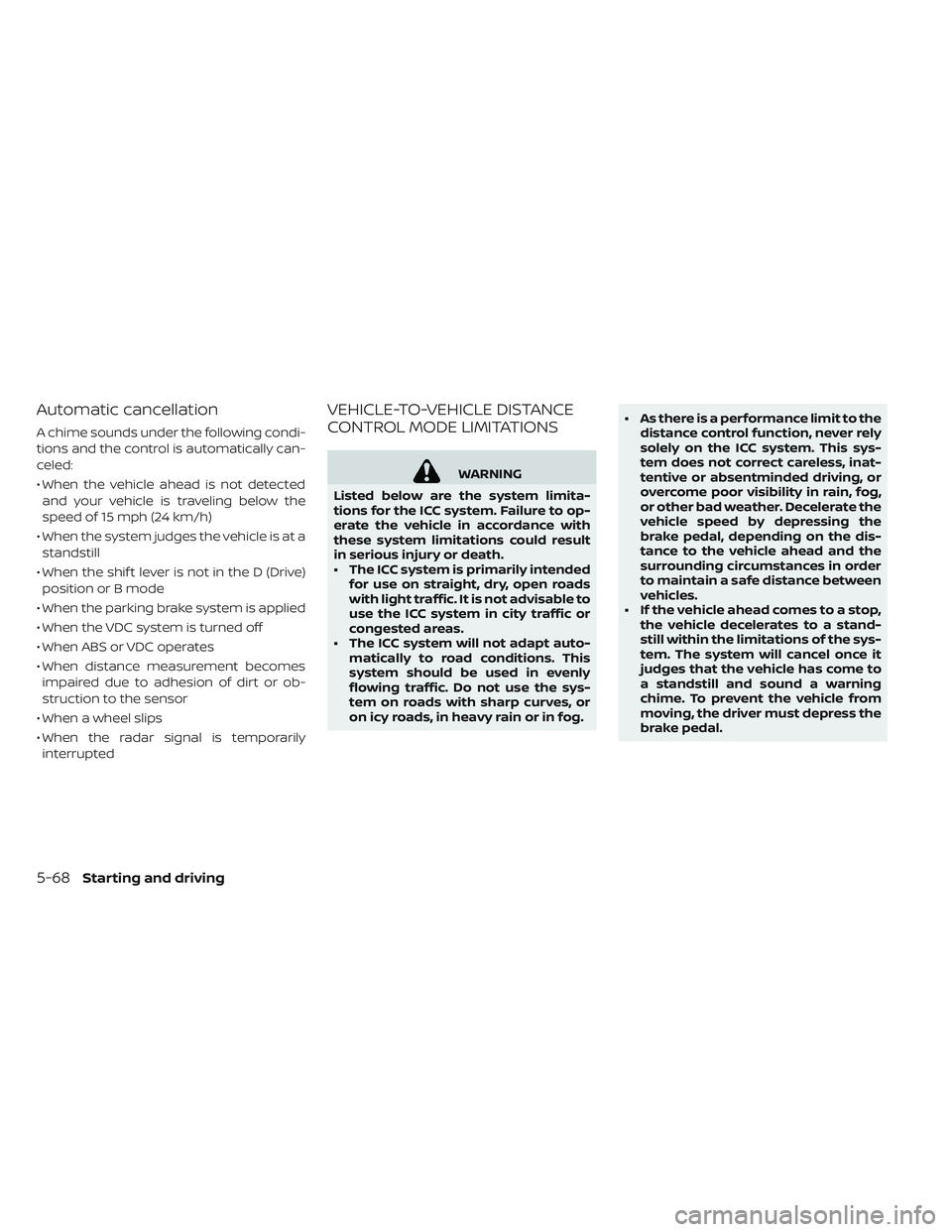
Automatic cancellation
A chime sounds under the following condi-
tions and the control is automatically can-
celed:
• When the vehicle ahead is not detectedand your vehicle is traveling below the
speed of 15 mph (24 km/h)
• When the system judges the vehicle is at a standstill
• When the shif t lever is not in the D (Drive) position or B mode
• When the parking brake system is applied
• When the VDC system is turned off
• When ABS or VDC operates
• When distance measurement becomes impaired due to adhesion of dirt or ob-
struction to the sensor
• When a wheel slips
• When the radar signal is temporarily interrupted
VEHICLE-TO-VEHICLE DISTANCE
CONTROL MODE LIMITATIONS
WARNING
Listed below are the system limita-
tions for the ICC system. Failure to op-
erate the vehicle in accordance with
these system limitations could result
in serious injury or death.
• The ICC system is primarily intended for use on straight, dry, open roads
with light traffic. It is not advisable to
use the ICC system in city traffic or
congested areas.
• The ICC system will not adapt auto- matically to road conditions. This
system should be used in evenly
flowing traffic. Do not use the sys-
tem on roads with sharp curves, or
on icy roads, in heavy rain or in fog. • As there is a performance limit to the
distance control function, never rely
solely on the ICC system. This sys-
tem does not correct careless, inat-
tentive or absentminded driving, or
overcome poor visibility in rain, fog,
or other bad weather. Decelerate the
vehicle speed by depressing the
brake pedal, depending on the dis-
tance to the vehicle ahead and the
surrounding circumstances in order
to maintain a safe distance between
vehicles.
• If the vehicle ahead comes to a stop, the vehicle decelerates to a stand-
still within the limitations of the sys-
tem. The system will cancel once it
judges that the vehicle has come to
a standstill and sound a warning
chime. To prevent the vehicle from
moving, the driver must depress the
brake pedal.
5-68Starting and driving
Page 439 of 610
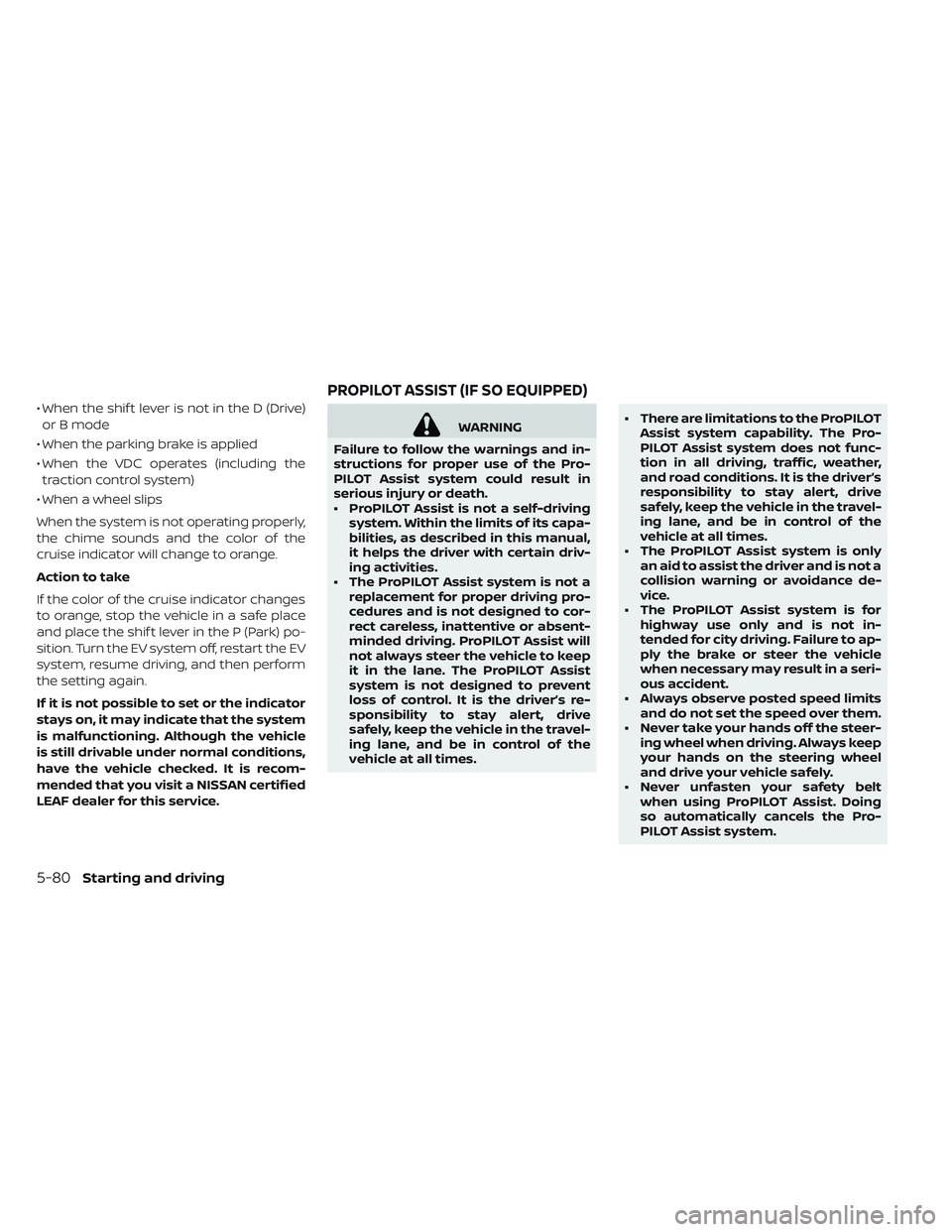
• When the shif t lever is not in the D (Drive)or B mode
• When the parking brake is applied
• When the VDC operates (including the traction control system)
• When a wheel slips
When the system is not operating properly,
the chime sounds and the color of the
cruise indicator will change to orange.
Action to take
If the color of the cruise indicator changes
to orange, stop the vehicle in a safe place
and place the shif t lever in the P (Park) po-
sition. Turn the EV system off, restart the EV
system, resume driving, and then perform
the setting again.
If it is not possible to set or the indicator
stays on, it may indicate that the system
is malfunctioning. Although the vehicle
is still drivable under normal conditions,
have the vehicle checked. It is recom-
mended that you visit a NISSAN certified
LEAF dealer for this service.
WARNING
Failure to follow the warnings and in-
structions for proper use of the Pro-
PILOT Assist system could result in
serious injury or death.
• ProPILOT Assist is not a self-driving system. Within the limits of its capa-
bilities, as described in this manual,
it helps the driver with certain driv-
ing activities.
• The ProPILOT Assist system is not a replacement for proper driving pro-
cedures and is not designed to cor-
rect careless, inattentive or absent-
minded driving. ProPILOT Assist will
not always steer the vehicle to keep
it in the lane. The ProPILOT Assist
system is not designed to prevent
loss of control. It is the driver’s re-
sponsibility to stay alert, drive
safely, keep the vehicle in the travel-
ing lane, and be in control of the
vehicle at all times. • There are limitations to the ProPILOT
Assist system capability. The Pro-
PILOT Assist system does not func-
tion in all driving, traffic, weather,
and road conditions. It is the driver’s
responsibility to stay alert, drive
safely, keep the vehicle in the travel-
ing lane, and be in control of the
vehicle at all times.
• The ProPILOT Assist system is only an aid to assist the driver and is not a
collision warning or avoidance de-
vice.
• The ProPILOT Assist system is for highway use only and is not in-
tended for city driving. Failure to ap-
ply the brake or steer the vehicle
when necessary may result in a seri-
ous accident.
• Always observe posted speed limits and do not set the speed over them.
• Never take your hands off the steer- ing wheel when driving. Always keep
your hands on the steering wheel
and drive your vehicle safely.
• Never unfasten your safety belt when using ProPILOT Assist. Doing
so automatically cancels the Pro-
PILOT Assist system.
PROPILOT ASSIST (IF SO EQUIPPED)
5-80Starting and driving
Page 456 of 610
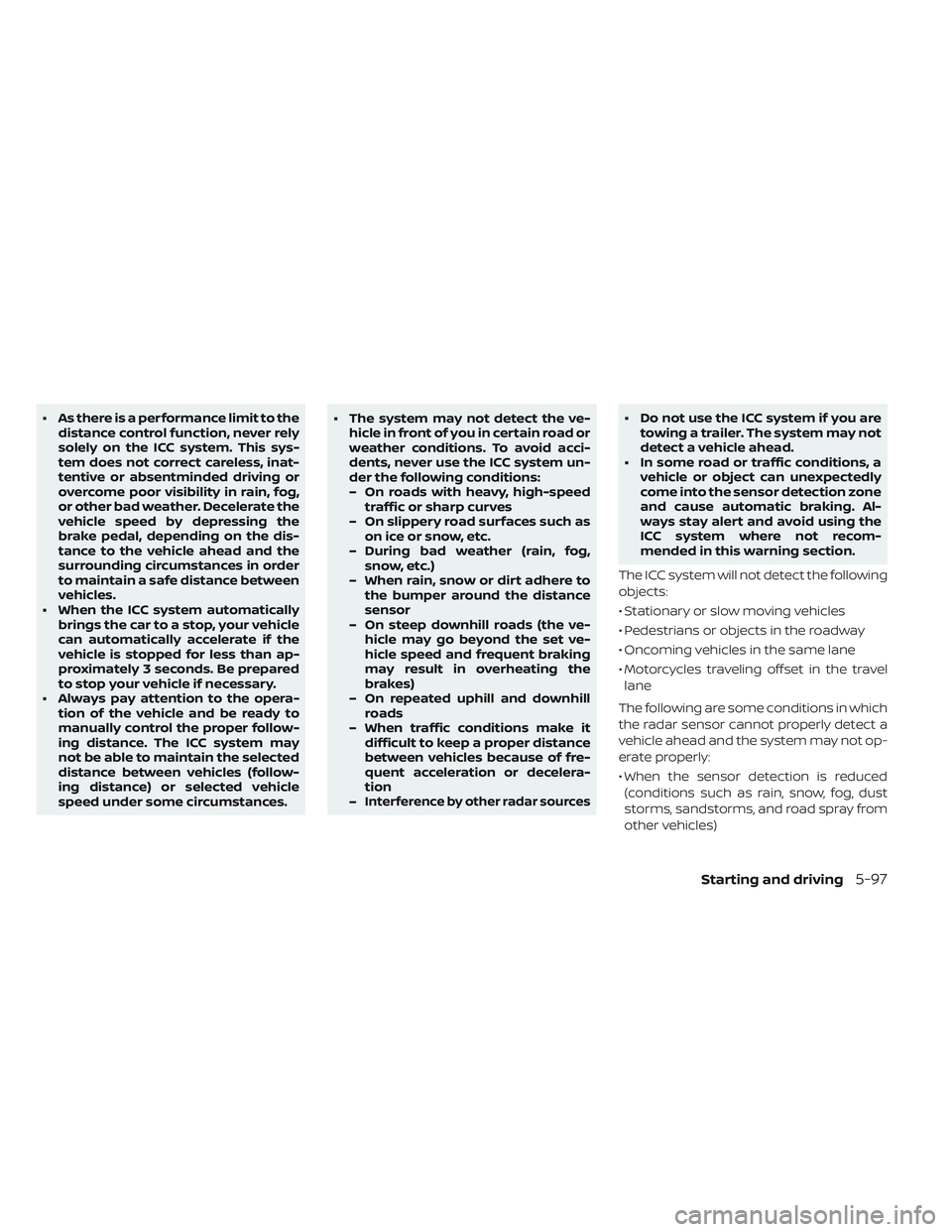
• As there is a performance limit to thedistance control function, never rely
solely on the ICC system. This sys-
tem does not correct careless, inat-
tentive or absentminded driving or
overcome poor visibility in rain, fog,
or other bad weather. Decelerate the
vehicle speed by depressing the
brake pedal, depending on the dis-
tance to the vehicle ahead and the
surrounding circumstances in order
to maintain a safe distance between
vehicles.
• When the ICC system automatically brings the car to a stop, your vehicle
can automatically accelerate if the
vehicle is stopped for less than ap-
proximately 3 seconds. Be prepared
to stop your vehicle if necessary.
• Always pay attention to the opera- tion of the vehicle and be ready to
manually control the proper follow-
ing distance. The ICC system may
not be able to maintain the selected
distance between vehicles (follow-
ing distance) or selected vehicle
speed under some circumstances. • The system may not detect the ve-
hicle in front of you in certain road or
weather conditions. To avoid acci-
dents, never use the ICC system un-
der the following conditions:
– On roads with heavy, high-speedtraffic or sharp curves
– On slippery road surfaces such as on ice or snow, etc.
– During bad weather (rain, fog, snow, etc.)
– When rain, snow or dirt adhere to the bumper around the distance
sensor
– On steep downhill roads (the ve- hicle may go beyond the set ve-
hicle speed and frequent braking
may result in overheating the
brakes)
– On repeated uphill and downhill roads
– When traffic conditions make it difficult to keep a proper distance
between vehicles because of fre-
quent acceleration or decelera-
tion
–
Interference by other radar sources
• Do not use the ICC system if you are towing a trailer. The system may not
detect a vehicle ahead.
• In some road or traffic conditions, a vehicle or object can unexpectedly
come into the sensor detection zone
and cause automatic braking. Al-
ways stay alert and avoid using the
ICC system where not recom-
mended in this warning section.
The ICC system will not detect the following
objects:
• Stationary or slow moving vehicles
• Pedestrians or objects in the roadway
• Oncoming vehicles in the same lane
• Motorcycles traveling offset in the travel lane
The following are some conditions in which
the radar sensor cannot properly detect a
vehicle ahead and the system may not op-
erate properly:
• When the sensor detection is reduced (conditions such as rain, snow, fog, dust
storms, sandstorms, and road spray from
other vehicles)
Starting and driving5-97
Page 461 of 610
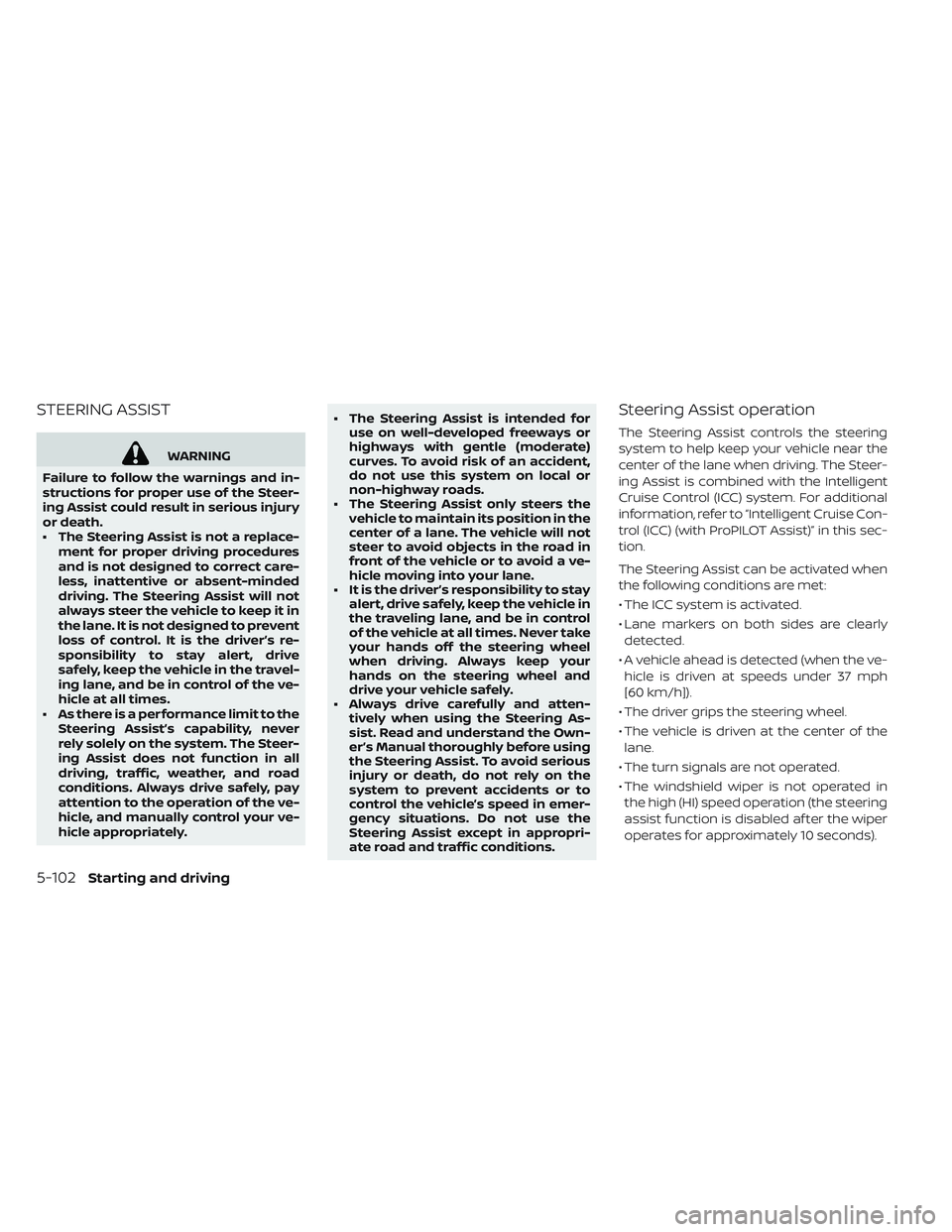
STEERING ASSIST
WARNING
Failure to follow the warnings and in-
structions for proper use of the Steer-
ing Assist could result in serious injury
or death.
• The Steering Assist is not a replace- ment for proper driving procedures
and is not designed to correct care-
less, inattentive or absent-minded
driving. The Steering Assist will not
always steer the vehicle to keep it in
the lane. It is not designed to prevent
loss of control. It is the driver’s re-
sponsibility to stay alert, drive
safely, keep the vehicle in the travel-
ing lane, and be in control of the ve-
hicle at all times.
• As there is a performance limit to the Steering Assist’s capability, never
rely solely on the system. The Steer-
ing Assist does not function in all
driving, traffic, weather, and road
conditions. Always drive safely, pay
attention to the operation of the ve-
hicle, and manually control your ve-
hicle appropriately. • The Steering Assist is intended for
use on well-developed freeways or
highways with gentle (moderate)
curves. To avoid risk of an accident,
do not use this system on local or
non-highway roads.
• The Steering Assist only steers the vehicle to maintain its position in the
center of a lane. The vehicle will not
steer to avoid objects in the road in
front of the vehicle or to avoid a ve-
hicle moving into your lane.
• It is the driver’s responsibility to stay alert, drive safely, keep the vehicle in
the traveling lane, and be in control
of the vehicle at all times. Never take
your hands off the steering wheel
when driving. Always keep your
hands on the steering wheel and
drive your vehicle safely.
• Always drive carefully and atten- tively when using the Steering As-
sist. Read and understand the Own-
er’s Manual thoroughly before using
the Steering Assist. To avoid serious
injury or death, do not rely on the
system to prevent accidents or to
control the vehicle’s speed in emer-
gency situations. Do not use the
Steering Assist except in appropri-
ate road and traffic conditions.
Steering Assist operation
The Steering Assist controls the steering
system to help keep your vehicle near the
center of the lane when driving. The Steer-
ing Assist is combined with the Intelligent
Cruise Control (ICC) system. For additional
information, refer to “Intelligent Cruise Con-
trol (ICC) (with ProPILOT Assist)” in this sec-
tion.
The Steering Assist can be activated when
the following conditions are met:
• The ICC system is activated.
• Lane markers on both sides are clearly
detected.
• A vehicle ahead is detected (when the ve- hicle is driven at speeds under 37 mph
[60 km/h]).
• The driver grips the steering wheel.
• The vehicle is driven at the center of the lane.
• The turn signals are not operated.
• The windshield wiper is not operated in the high (HI) speed operation (the steering
assist function is disabled af ter the wiper
operates for approximately 10 seconds).
5-102Starting and driving
Page 507 of 610
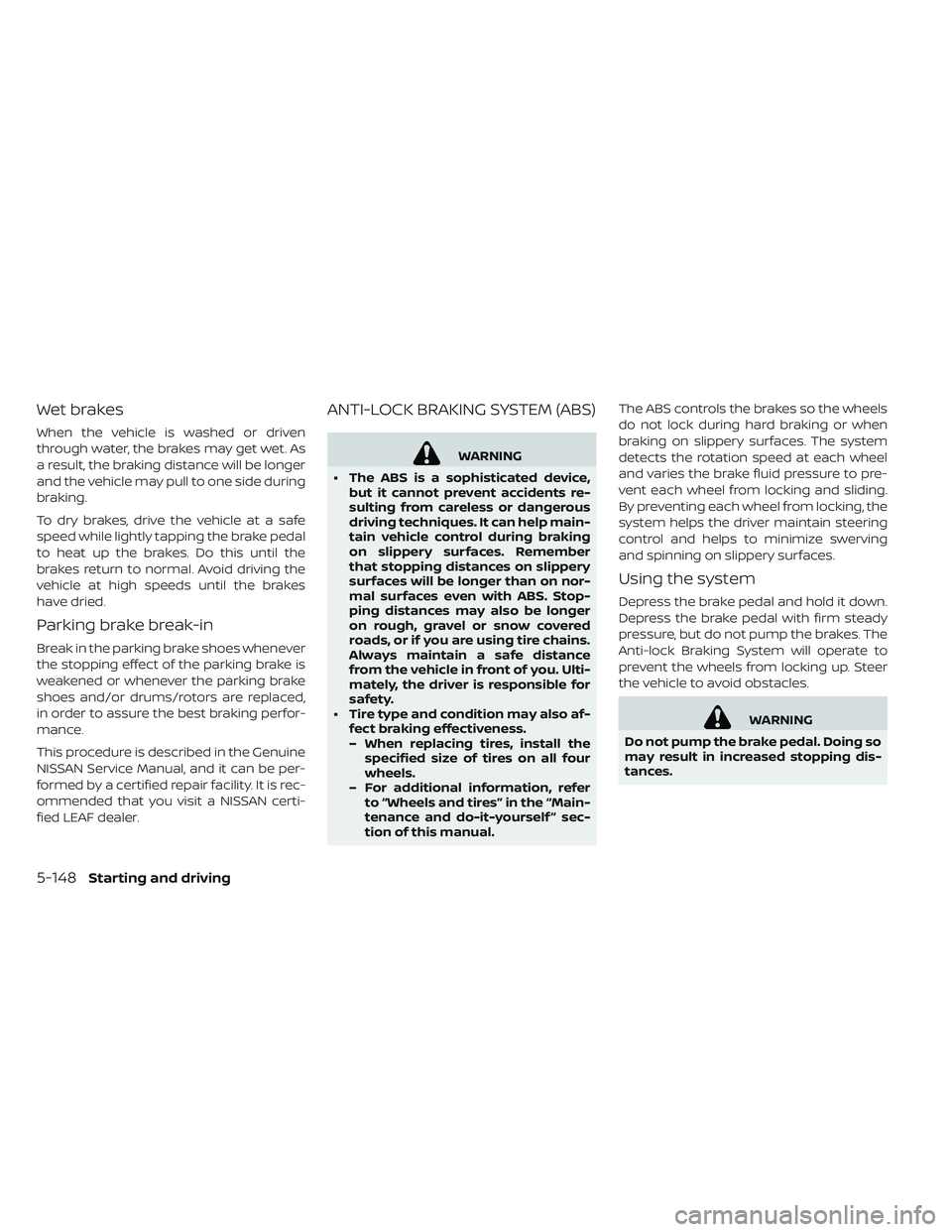
Wet brakes
When the vehicle is washed or driven
through water, the brakes may get wet. As
a result, the braking distance will be longer
and the vehicle may pull to one side during
braking.
To dry brakes, drive the vehicle at a safe
speed while lightly tapping the brake pedal
to heat up the brakes. Do this until the
brakes return to normal. Avoid driving the
vehicle at high speeds until the brakes
have dried.
Parking brake break-in
Break in the parking brake shoes whenever
the stopping effect of the parking brake is
weakened or whenever the parking brake
shoes and/or drums/rotors are replaced,
in order to assure the best braking perfor-
mance.
This procedure is described in the Genuine
NISSAN Service Manual, and it can be per-
formed by a certified repair facility. It is rec-
ommended that you visit a NISSAN certi-
fied LEAF dealer.
ANTI-LOCK BRAKING SYSTEM (ABS)
WARNING
• The ABS is a sophisticated device, but it cannot prevent accidents re-
sulting from careless or dangerous
driving techniques. It can help main-
tain vehicle control during braking
on slippery surfaces. Remember
that stopping distances on slippery
surfaces will be longer than on nor-
mal surfaces even with ABS. Stop-
ping distances may also be longer
on rough, gravel or snow covered
roads, or if you are using tire chains.
Always maintain a safe distance
from the vehicle in front of you. Ulti-
mately, the driver is responsible for
safety.
• Tire type and condition may also af- fect braking effectiveness.
– When replacing tires, install thespecified size of tires on all four
wheels.
– For additional information, refer to “Wheels and tires” in the “Main-
tenance and do-it-yourself ” sec-
tion of this manual. The ABS controls the brakes so the wheels
do not lock during hard braking or when
braking on slippery surfaces. The system
detects the rotation speed at each wheel
and varies the brake fluid pressure to pre-
vent each wheel from locking and sliding.
By preventing each wheel from locking, the
system helps the driver maintain steering
control and helps to minimize swerving
and spinning on slippery surfaces.
Using the system
Depress the brake pedal and hold it down.
Depress the brake pedal with firm steady
pressure, but do not pump the brakes. The
Anti-lock Braking System will operate to
prevent the wheels from locking up. Steer
the vehicle to avoid obstacles.
WARNING
Do not pump the brake pedal. Doing so
may result in increased stopping dis-
tances.
5-148Starting and driving